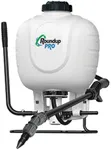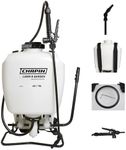Buying Guide for the Best Weed Sprayers
Choosing the right weed sprayer can make your gardening or landscaping tasks much easier and more effective. The best sprayer for you depends on the size of the area you need to treat, how often you plan to use it, and your comfort with carrying or operating the equipment. Understanding the main features and specifications will help you select a sprayer that matches your needs and ensures efficient, safe application of weed control products.Tank CapacityTank capacity refers to how much liquid the sprayer can hold at one time. This is important because it determines how much area you can cover before needing to refill. Small tanks (1-2 gallons) are lightweight and suitable for small gardens or spot treatments, while medium tanks (3-4 gallons) are good for larger yards. Large tanks (5 gallons or more) are best for big properties or commercial use but can be heavy to carry. Choose a tank size that matches the size of your typical spraying job and your ability to comfortably handle the weight.
Sprayer TypeThere are several types of weed sprayers, including handheld, backpack, wheeled, and tow-behind models. Handheld sprayers are compact and easy to use for small jobs. Backpack sprayers distribute weight across your back and are ideal for medium to large areas, offering more comfort for longer use. Wheeled and tow-behind sprayers are designed for very large areas and reduce the need to carry weight, making them suitable for people with mobility concerns or for treating fields. Consider the size of your property and your physical comfort when choosing a sprayer type.
Pump MechanismThe pump mechanism is how the sprayer builds pressure to spray the liquid. Manual pumps require you to pump by hand, which is simple and reliable for small jobs. Battery-powered or electric pumps do the work for you, making them easier to use for larger areas or frequent spraying, but they require charging or batteries. If you have a lot of spraying to do or want to reduce physical effort, a powered pump may be a better choice.
Nozzle OptionsNozzles control the spray pattern and droplet size, which affects how evenly and efficiently you apply weed killer. Adjustable or interchangeable nozzles let you switch between a fine mist for broad coverage and a targeted stream for spot treatments. If you need to treat different types of weeds or areas, look for a sprayer with multiple nozzle options. For simple, single-purpose use, a fixed nozzle may be sufficient.
Material and DurabilityThe material of the sprayer, usually plastic or metal, affects its durability and resistance to chemicals. High-quality plastic is lightweight and resistant to corrosion, while metal parts can add strength but may be heavier. If you plan to use strong chemicals or want a sprayer that lasts for many seasons, look for models with chemical-resistant seals and sturdy construction. For occasional, light use, a basic plastic sprayer may be enough.
Ease of CleaningCleaning your sprayer after each use is important to prevent clogs and chemical buildup. Some sprayers have wide openings or removable parts that make cleaning easier. If you want to save time and effort, look for a sprayer designed for easy maintenance. This is especially important if you plan to use different chemicals in the same sprayer.















